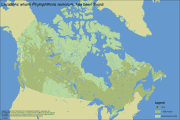Ramorum blight; Sudden Oak Death

- Latin : Phytophthora ramorum (Pr)
- English: Ramorum blight; Sudden Oak Death
- French: Encre des chênes rouges
- Order/Class: Stilbellales
Description
Distribution
This species is not found in Canada
Micro-habitat(s)
Damage, symptoms and biology
In California, the disease occurs in two forms: leaf blight, in which the leaves turn brown and dry within a very short time period, usually 2 to 4 weeks. While the foliar form of the disease is seldom lethal, it weakens the tree, allowing secondary pathogens to attack. The second form of the disease manifests itself as cankers, which develop on the trunk or branches and are the result of a scarring process reflecting the living tissues’ response to the invading fungus. Initially, sap will be seen seeping from the intact bark or in areas where there are depressions or injuries. At a more advanced stage of the disease, the bark splits and cankers begin to form. These cankers are not found on young trees with a diameter smaller than 10 cm. Cankers, which range in colour from reddish brown to almost black and seep red or amber sap, usually develop 1 to 2 m above the ground, although they can also be found near the base of the trunk or higher up.
Comments
Sudden oak death was identified in Europe in the early 1990s and then in the United States in 1995. It is a highly virulent disease that can kill an adult oak in just a few weeks. In California, the disease has killed thousands of oaks and has proven to be especially damaging for tanoak (Lithocarpus densiflorus), infecting all parts of the tree. The causal organism, Phytophthora ramorum, is considered a serious threat to the forest ecosystems of North America.
In Canada, three zones have been identified in which the disease could cause severe damage: British Columbia, owing to its proximity to California, and southern Quebec and Ontario, where red oak is a potential host. Balsam fir, white ash and yellow birch could favour spore production of the blight, leading to the infection of neighbouring trees. It is almost impossible to eradicate the causal organism once it has become established in the natural environment. The foliar form of sudden oak death and its wide host range are factors that contribute to the rapid dispersal of spores of Phytophthora ramorum.
Although the disease has been found in both Europe and North America, its geographic origin has not been determined. In Europe, a similar disease attributed to Phytophthora cinnamomi, likewise a bleeding canker, is reported to reduce the value of logs without killing the host oak trees.
References
California Oak Mortality Task Force. 2007. Symptoms & Diagnosis. http://nature.berkeley.edu/comtf/html/symptoms___diagnosis.html. Accessed in 2009.
Département de la santé des forêts. 2010. Phytophthora ramorum sur mélèze, une découverte inquiétante en Angleterre. http://agriculture.gouv.fr/IMG/pdf/phytophtora_ramorum_sur_meleze0810.pdf. Accessed December 20, 2011.
Jinek, A.; Simard, M.; Brière, S.C.; Watson, A.K.; Tweddell, R.J.; Rioux, D. 2011. Foliage susceptibility of six eastern Canadian forest tree species to Phytophthora ramorum. Can. J. Plant Pathol. 33:26-37.
Rioux, D. 2006. Sudden oak death: vigilance! Natural Resources Canada, Branching Out from the Canadian Forest Service, Laurentian Forestry Centre, No. 25, 2 pp.
Rioux, D.; Callan, B.; McKenney, D. 2006. Phytophthora ramorum : Quel est le risque pour l’Est du Canada? 98e Assemblée annuelle de la Société de protection des plantes du Québec, Résumé des communications. Phytoprotection 87:93-96.
Turbis, C.; DesRochers, P. 2007. Les ravageurs forestiers exotiques - Une menace potentielle pour les forêts du Québec. Partenariat Innovation Forêt, Québec, Publi-reportage, Progrès forestier, octobre 2007, pp. 24-25.
USDA Forest Service. National Forest Health Monitoring. 2007. http://www.fs.fed.us/foresthealth/fhm/sp/sod/sod.shtml. Accessed in 2009 and 2011.
Webber, J.F.; Mullett, M.; Brasier, C.M. 2010. Dieback and mortality of plantation Japanese larch (Larix kaempferi) associated with infection by Phytophthora ramorum. New Dis. Rep. 22:19. http://www.ndrs.org.uk/pdfs/022/NDR_022019.pdf. Accessed May 11, 2011.
